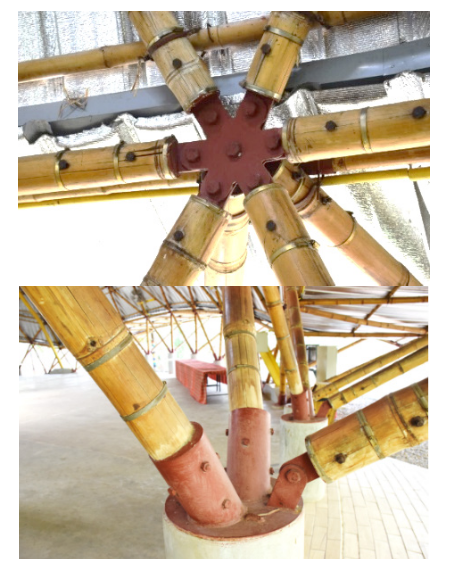A Study of Methods, Instruments, and Evaluating Architectural Identities Leading to the Development of Modern Bamboo Architectural Identities in Thailand
Main Article Content
Abstract
Linking the concepts of identity and architecture identity to modern bamboo architecture still retains significant educational gaps about many issues. This article focuses on methods, instruments, and evaluations used in studying architectural identity, leading to the development of modern bamboo architecture identity. An information system search using the keywords “Architecture Identity” from 2007 to 2020 turned up 52 relevant research articles, each with different theories, methods, instruments, and evaluations. Results included: 1) architectural typology and style mostly found in ethnic houses were vernacular architecture; 2) the study of architectural identity as part of district or community identity was researched more than other groups; and 3) physical surveying of physical architecture, interviewing, and asking relevant persons were used in the methodology. The study of modern bamboo architectural identity is specific to many dimensions, not just physical appearance denotation such as construction technology level, structural complexity, joint type, shape, usage, and bamboo species. There is also the abstract dimension, including symbolic or other influences. Connotative meanings include beliefs, wisdom, values, and culture in construction. These variables make the study of bamboo architecture unique, affecting the consideration of appropriate methodology, especially pilot surveying and interviewing relevant parties. This is a preliminary method for obtaining operational and qualitative variables to make indicators of this study of bamboo architecture identity in Thailand more specific.
Downloads
Article Details

This work is licensed under a Creative Commons Attribution-NonCommercial-NoDerivatives 4.0 International License.
All material is licensed under the terms of the Creative Commons Attribution 4.0 International (CC-BY-NC-ND 4.0) License, unless otherwise stated. As such, authors are free to share, copy, and redistribute the material in any medium or format. The authors must give appropriate credit, provide a link to the license, and indicate if changes were made. The authors may do so in any reasonable manner, but not in any way that suggests the licensor endorses you or your use. The authors may not use the material for commercial purposes. If the authors remix, transform, or build upon the material, they may not distribute the modified material, unless permission is obtained from JARS. Final, accepted versions of the paper may be posted on third party repositories, provided appropriate acknowledgement to the original source is clearly noted.
References
Arboleda, G. (2006). What is Vernacular Architecture? Ethno-Architecture, (Doctoral Dissertation). College of Environmental Design, University of California at Berkley.
Boonprasong, P. (2019). Place Identity in Use Transformation Process of Old Building in The Old Town. Journal of Architectural Planning Research and Studies, 16(2), 31-48.
Fungfusakul, A. (2018). Identites. Chiang Mai: Department of Sociology and Antropology, Faculty of Social Sciences, Chiang Mai University.
Fusinpaipoon, C. (2016). The Historiography of Modern Architecture in Thailand. NAJUA: History of Architecture and Thai Architecture, 13(1), 154-173.
Geertz, C. (1983). Local Knowledge: Further Essays in Interpretive Anthropology. New York: Basic Books.
Harachai, P., & Bejrananda, M. (2019). The Perception of the Insider and Outside of Place Identity Buriram Province. Journal of Architectural Planning Research and Studies, 16(2), 49-68.
Horayangkura, V. (2019). Design-Research: Integration and Methodology. Bangkok: Thammasat University Press.
Horayangkura, V., Seartworakit, B., & Inpantang, V. (2015). Research for Fundamental of Thai Architecture Identity, (Thailand Research Fund). GBP Center Bangkok.
Jensantikul, N. (2017). Utilizing the Delphi Technique for Research. Political Science Review Journal, 4(2), 47-64.
Kumya, T. (2014). Research for A study on the identify of architecture in nakhonchum historical community, Amphoe Mueang, Kamphaeng Phet, (Master’s Thesis). Faculty of Architecture, Silpakorn University.
Littinun, N., Punjarporn, R., & Sittiprasert, K. (2019). The Decoding Signification in Architecture of Academic Institution Buildings in the Northeastern Region. Arch KMITL journal, 29(2), 75-91.
Pama, T., & Haocharoen K. (2019). Cultural Identity of Taladlang Community, Lopburi Province. Journal of Architectural Planning Research and Studies, 16(2), 69-92.
Prakitnontakan, C. (2015). Thai Architecture after the coup 19th September 2006. Bangkok: Read journal Publisher.
Rattanapun, N., Jarean, N., & Chanasit, N. (2015). Research for A Study of Identity of MICE city: A case of Songkhla, (Research Project No. ENV580506d). Songkhla University.
Sriprasert, C. (2011). Research for A design project of Corporation Identity for Promoting case study I-SAC Tutor, (Bachelor’s Thesis). Communication Art and Design, Faculty of Humanities and Social Sciences, Chandrakasem Rajabhat University.
Sakeungsintukul, K., & Artruksa, W. (2018). The Study of Architectural Identity in Correlation with Urban Heritage Area: The Case of Yaowaraj Road. Arch KMITL journal, 27(2), 152-166.
Sankham, P., & Sirachainan, E. (2017). A Study on the Architectural Identity of the Chanthaboon Waterfront Community for Store Interior Environment Design Guideline. Built Environment Inquiry Journal (BEI), 16(1), 41-54.
Suwatcharapinun, S., & Fungfusakul, A. (2012). Phenomenology: Rethinking the Uses of “Root and Identity” in Thai Contemporary Architectural Discourse. Built Environment Research Associates Conference, BERAC 3(1), 35-48.
Suwatcharapinun, S., & Fungfusakul, A. (2012). Semiology: Decoding and Applying Thai Identities for Design Guidelines. Built Environment Research Associates Conference, BERAC 3(1), 86-102.
Thanatit, S. (2016). Perception of Lanna Identity via Architecture in Chiang Mai Province. Arch KMITL journal, 23(2), 31-41.
Uthaipattrakoon, T. (2016). Research for Process design and Construction: A case of Bamboo Art Hall. Arsom Silp Institute of The Arts.
Widyowijatnoko, A. (2012). Research for Conventional vs. Substitutive Bamboo Construction: The classification of Bamboo Construction. RWTH Aachen University.

